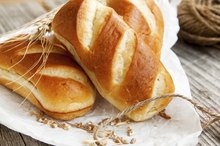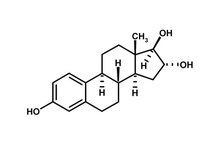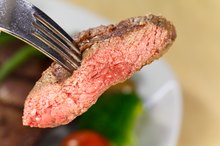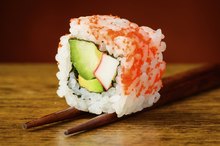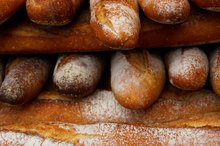Foods Containing Carbon
Whether you bite into an apple, steak or dish of ice cream, you’re sure to get plenty of one type of element: carbon. Because carbon is present in all known forms of life, every food we eat contains carbon. Carbon is unique in its ability to form large, diverse molecules because of the way it forms electronic bonds with other atoms. The chemical bonds carbon forms allow it to form long molecular chains essential to life as we know it.
The Facts
Large carbon-based molecules are called organic macromolecules. There are four major groups of macromolecules: fats, carbohydrates, proteins and nucleic acids 2. All four share the basic property of having a carbon atom “skeleton,” but differing chemical properties mean that each type of macromolecule has a unique function in diet and health.
- Large carbon-based molecules are called organic macromolecules.
- There are four major groups of macromolecules: fats, carbohydrates, proteins and nucleic acids 2.
Fats
The Major Importance of Hydrogen in Living Organisms
Learn More
Fats are energy storing molecules made from two smaller molecules: glycerol, a three-carbon alcohol, attached to a long carbon chain fatty acid “tail” which makes the fat insoluble in water. Most of us know have heard that unsaturated fats are healthier than saturated fats, and the difference between these two has to do with the kinds of bonds the carbon atoms in the fatty acid tail form. In a saturated fat, each carbon atom forms only single bonds with hydrogen and other atoms in the molecule. This creates a fatty acid with a straight “tail,” which allows many saturated fat molecules to be packed tightly together in a relatively small space. This tight packing is why saturated fats, like lard or butter, are solid at room temperature. Tight packing of fat molecules is also why saturated fats are less healthy than unsaturated fats. In an unsaturated fat, some carbon atoms form double bonds with other atoms. These double bonds create a kink in the tail of the fatty acid, which means that the molecules can’t pack tightly together. This is why an unsaturated fat, like olive oil, is liquid at room temperature.
- Fats are energy storing molecules made from two smaller molecules: glycerol, a three-carbon alcohol, attached to a long carbon chain fatty acid “tail” which makes the fat insoluble in water.
- Most of us know have heard that unsaturated fats are healthier than saturated fats, and the difference between these two has to do with the kinds of bonds the carbon atoms in the fatty acid tail form.
Carbohydrates
Breads, grains, sugars and starches like potatoes are all carbohydrates 2. Carbohydrates are critical energy sources for most living organisms and can also function as food storage molecules in the body 2. Carbohydrates are chains of carbon, hydrogen and oxygen that can be broken down into basic glucose, or fructose sugar rings 2. Cellulose is the tough, fibrous carbohydrate found in wood and other plant materials and is the most abundant organic compound on earth. Humans can’t digest cellulose, but it’s still an important dietary element. Cellulose, also known as fiber, is found in many fruits, grains and vegetable and has many important functions in human health. Because it must be thoroughly chewed, it slows eating and contributes to feelings of fullness. It also helps regulate blood sugar levels and cleans the lining of the digestive system.
- Breads, grains, sugars and starches like potatoes are all carbohydrates 2.
- Cellulose, also known as fiber, is found in many fruits, grains and vegetable and has many important functions in human health.
Proteins
Organic Compounds That Must Be in the Diet
Learn More
Proteins are found in meats, nuts, dairy products, grains and legumes. Protein is essential for nearly all of life’s functions. Protein consists of a carbon skeleton joined to differing arrangements of the 20 amino acids that form the building blocks for all proteins. Proteins are important in constructing our cells, starting and regulating our body’s chemical reactions, helping our immune systems function and allowing communication between our cells. Our hair, muscles and connective tissues like ligaments and tendons are made of proteins.
- Proteins are found in meats, nuts, dairy products, grains and legumes.
- Proteins are important in constructing our cells, starting and regulating our body’s chemical reactions, helping our immune systems function and allowing communication between our cells.
Nucleic Acids
The fourth major group of macromolecules isn’t directly related to diet, but is critical for life. Nucleic acids are carbon skeletons joined to nucleotides, which are carbon-based sugars linked to a nitrogenous base. Nucleic acids are the basic building blocks of our DNA and RNA, which carry the genetic code responsible for all of the structures and functions of the body.
Related Articles
References
- Biology: Concepts and Connections; Neil A. Campbell; 2009
- What Are Carbohydrates?
- Gropper SS, Smith JL, Groff JL. Advanced Nutrition and Human Metabolism. Sixth Edition. Belmont, CA. Wadsworth Publishing Company, 2013.
- Smolin LA, Grosvenor, MB. Nutrition: Science and Applications. Third Edition. Wiley Publishing Company, 2013.
- United States Department of Health and Human Services, National Digestive Diseases Information Clearinghouse (NDDIC). "Your Digestive System and How It Works."
Writer Bio
Liz Veloz is a writer, scientist and college teacher living in Madison, Wis. Her science, travel and adventure writing has appeared in numerous literary journals and other publications. Veloz holds a doctorate in the biological sciences and a Master of Arts in English from the University of California, Davis.





